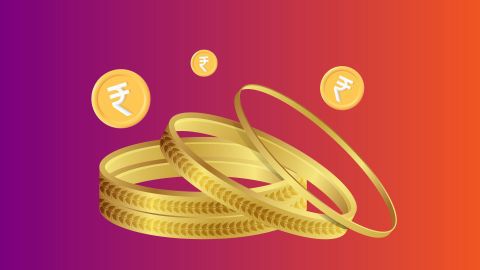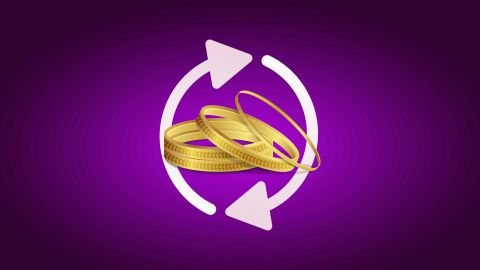2 mins
29 July 2024
Gold, a valuable metal, is prized for its rarity, lustre, and malleability. Its purity is measured in carats, with 24 carats being pure gold. Commonly used variants like 22-carat and 18-carat gold blend gold with alloys, enhancing durability for jewellery while maintaining significant value.
How gold purity is measured in carat gold?
Gold purity in carats is determined by the ratio of gold to other metals in an alloy. The purity is measured on a scale of 24, where 24-carat gold is 100% pure. To calculate, the gold content is divided by 24, giving a percentage of purity. For example, 18-carat gold contains 75% gold (18 divided by 24). In India, hallmarking standards ensure accuracy in gold purity, with hallmark symbols indicating the carat value. Jewellers use these standards to assure customers of the gold's authenticity and purity, maintaining trust and transparency in the market.
Does a higher carat mean higher quality gold?
While a higher carat value means higher gold content, it does not necessarily translate to higher quality in terms of durability and wearability. Pure 24-carat gold is soft and prone to scratching, making it less suitable for everyday wear. In contrast, lower carat gold, like 18-carat or 14-carat, is alloyed with other metals, enhancing its strength and resistance to damage. Therefore, "quality" depends on the intended use of the gold item. For daily wear jewellery, lower carat gold offers better durability, while high carat gold is prized for its purity and bright yellow hue.Durability and wearability of different carats of gold
Durability and wearability vary significantly across different carat golds. Higher carat gold, such as 22-carat or 24-carat, while visually appealing and more valuable due to its purity, is softer and more prone to scratches and deformation. This makes it less ideal for items subjected to daily wear and tear. Conversely, lower carat gold, like 18-carat or 14-carat, contains a higher proportion of alloyed metals, enhancing its strength and making it more resistant to damage. For those seeking long-lasting, durable jewellery for everyday use, lower carat gold options provide a balance of beauty and practicality.Factors to consider when selecting a carat of gold
When selecting carat gold, consider several factors to ensure you make an informed choice. First, think about the intended use of the jewellery. For daily wear, lower carat gold, such as 18-carat, offers better durability. Second, consider your budget; higher carat gold is more expensive due to its higher gold content. Third, personal preference for the gold's colour and appearance plays a role; higher carat gold has a richer yellow hue. Lastly, consider potential resale value and market demand. In India, 22-carat gold is popular for its balance of purity and strength, making it a common choice for jewellery.Understanding cost vs value of gold by carat
The cost of gold jewellery increases with the carat value due to the higher gold content. However, value is not solely determined by purity. High carat gold, such as 22-carat or 24-carat, offers excellent purity but at a premium price and reduced durability. Lower carat gold, like 18-carat, is more affordable and provides enhanced strength, making it suitable for everyday wear. When evaluating cost versus value, consider the jewellery's purpose, longevity, and your budget. In India, while higher carat gold is often seen as an investment, lower carat gold offers practical value for those seeking durable, stylish pieces for regular use.Frequently asked questions
What does carat mean in gold?
Carat in gold refers to the measure of gold purity in an alloy, expressed in parts per 24. Pure gold is 24-carat, meaning it is 100% gold. For example, 18-carat gold contains 18 parts gold and 6 parts other metals, making it 75% pure. The higher the carat number, the greater the gold content. This system helps consumers understand the value and composition of gold jewellery, balancing purity with strength and durability.
Which carat of gold is best for jewellery?
For jewellery, 22-carat and 18-carat gold are often considered the best choices. 22-carat gold offers a high level of purity while retaining sufficient strength for traditional jewellery. However, 18-carat gold is more durable due to its higher alloy content, making it ideal for everyday wear. It balances purity with practicality, providing a beautiful gold hue and greater resistance to scratches and deformation, ensuring long-lasting elegance.
Is 24-carat gold better than 22-carat gold?
Whether 24-carat gold is better than 22-carat gold depends on the context. 24-carat gold is purer and has a brighter yellow hue, making it more valuable and attractive for investment. However, it is softer and less durable, prone to scratches and bending. 22-carat gold, with a small amount of alloyed metals, offers better strength and durability, making it more suitable for jewellery worn daily. Thus, the choice depends on the intended use and personal preferences.
How does carat rating affect gold loans?
The carat rating significantly affects gold loans, as higher carat gold, such as 22-carat or 24-carat, contains more pure gold, thus having a higher market value. Lenders typically offer higher loan amounts for gold with higher carat ratings due to its greater worth. Conversely, gold with a lower carat rating, like 18-carat, fetches a lower loan amount. Therefore, borrowers with higher carat gold can secure larger loans compared to those with lower carat gold.
Show More
Show Less
Bajaj Finserv app for all your financial needs and goals
Trusted by 50 million+ customers in India, Bajaj Finserv App is a one-stop solution for all your financial needs and goals.
You can use the Bajaj Finserv App to:
- Apply for loans online, such as Instant Personal Loan, Home Loan, Business Loan, Gold Loan, and more.
- Invest in fixed deposits and mutual funds on the app.
- Choose from multiple insurance for your health, motor and even pocket insurance, from various insurance providers.
- Pay and manage your bills and recharges using the BBPS platform. Use Bajaj Pay and Bajaj Wallet for quick and simple money transfers and transactions.
- Apply for Insta EMI Card and get a pre-qualified limit on the app. Explore over 1 million products on the app that can be purchased from a partner store on Easy EMIs.
- Shop from over 100+ brand partners that offer a diverse range of products and services.
- Use specialised tools like EMI calculators, SIP Calculators
- Check your credit score, download loan statements and even get quick customer support—all on the app.
Download the Bajaj Finserv App today and experience the convenience of managing your finances on one app.






